Phytosterols (PS), are plant-derived compounds from the triterpene family and are structurally similar to cholesterol found in animal products or pregnenolone, an endogenous steroid in our body. PS have the same function in plants as cholesterol in animals, regulating cell membrane fluidity and permeability.
They are present in small quantities in many fruits, vegetables, nuts, seeds, cereals, legumes, and vegetable oils. Foods rich in PS are wheat germ and bran, olive oil, oranges, cauliflower, passion fruit, and almonds. Although even these are low in PS overall.
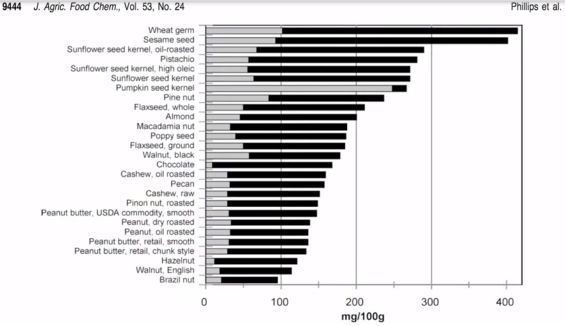
Phytosterols are better absorbed when present in foods that have fat, like nuts and seeds. If you supplement, it would be better to take them together with a meal that contains fat (8).

The intake of PSs varies significantly around the world, with average daily intakes reported as 140 to 360 mg in Finland, 375 mg in Japan, and 359 mg in the Netherlands. In the United Kingdom, the average daily intake is around 300 mg for men and 293 mg for women, primarily through bread, cereals, fats, and vegetables. In Belgium, the intake ranges from 172 to 194 mg for preschool children and 218 to 280 mg for adults.
According to the simulated “Simian diet” by Jenkins, the diet our primate ancestors would have eaten, a daily intake of 1 gram of phytosterols would have been reached (2.5 to 5 times higher as compared to levels in our current diets) (14).
By the Neolithic, this would supposedly have dropped to 405 mg. A level modern vegetarians seem to get daily (let’s use this amount as the “normal for a healthy modern diet”). Westerners seem to get around 300 mg. If you’re wondering why modern levels are still relatively high (compared to 10,000 years ago that is), this is because plant seed oils, widely used in our supermarket foods are high in PS.
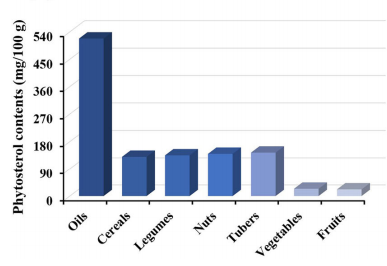
The bioaccessibility of PSs is only around 2% to 6% absorbed through the intestine, with the remainder being excreted.

In the human body, the absorption of plant sterols and dietary cholesterol primarily occurs in the intestine, where the Niemann-Pick C1-like 1 (NPC1L1) transporter plays a crucial role in their initial uptake. Following absorption, sterols are esterified with the assistance of ACAT and transported to the liver via chylomicrons, while unesterified sterols are expelled by the ABCG5 and ABCG8 transporters. The efflux of these sterols and cholesterol from plasma is regulated by the ABCA1 transporter, which facilitates the assembly of HDL-like particles. These processes are integral to the metabolism of plant sterols, which also involves the activation of LXR receptors, influencing APOE expression for HDL and LDL assembly and uptake. Additionally, plant sterols can upregulate ABCG5/G8 transporters, enhancing sterol absorption. The HDL-like particles containing plant sterols are then targeted by SR-BI receptors on the liver and adrenal glands, essential for cholesterol uptake and crucial for brain lipid metabolism.
Types and Variability
There are several different types of phytosterols, with beta-sitosterol, campesterol, and stigmasterol being the most common. The differences between these and other phytosterols lie in the presence or absence of ethyl or methyl groups at specific positions on the side chain or in the degree of unsaturation (double bonds) within the ring structure or side chain. All plant species have their characteristic PS composition (Ogbe et al., 2015), with more than 250 PS being recognized so far.
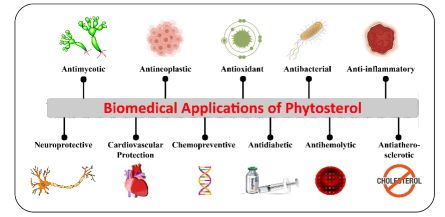
A wide number of studies have reported remarkable pharmacological effects of PSs, acting as chemopreventive, anti-inflammatory, antioxidant, antidiabetic, and antiatherosclerotic agents. There is some conflicting safety data, but not enough to warrant a warning here. Here are several health benefits associated with phytosterol supplementation, based on scientific research:
Cholesterol Management:
Phytosterols can lower low-density lipoprotein (LDL) cholesterol, often referred to as "bad" cholesterol, without significantly affecting high-density lipoprotein (HDL) cholesterol, or "good" cholesterol, and triglyceride levels. The cardioprotective properties of plant sterols, particularly their ability to lower triglyceride and cholesterol levels, have been well-documented across numerous studies, with a consensus that a daily intake of approximately 2.5 g of dietary plant sterols can reduce circulating triglycerides by 9.5%, and low-fat soy beverages may lower LDL-C by 13%.
A comprehensive meta-analysis spanning 124 studies identified that while the general population's intake ranges from 0.2 to 9.0 g per day, as little as 0.6 to 3.3 g daily is adequate to decrease LDL-cholesterol serum levels, with effects amplifying up to 12% upon reaching a 3 g daily intake. (T. Kopylov 2021). It is generally accepted that 1–3 g of a daily dose of phytosterols leads to a 10–15% decrease in total cholesterol levels and also decreases plasma LDL-cholesterol (Patel et al., 2018; Nakano et al., 2019).
Our body has cholesterol receptors, and these mistakenly absorb PS, thinking that they are real cholesterol. Before the receptor can figure out that it’s not true cholesterol, the receptor would have been occupied and saturated, meaning that real cholesterol was expelled because it didn’t get a chance to reach the receptor. PS further lowers cholesterol by enhancing ABC-type transport protein and by cholesterol esterification. In this way, our LDL can be lowered by a few percentage points when supplementing PS.
The metabolic response to phytosterols varies among individuals (Jones, 2015). This can be due to genetic differences, for example in genes encoding ApoE and CyP7A1. Some RCTs show 0 effects, some show a 10% reduction in LDL. The EFSA has granted a health claim for lowering cholesterol through PS supplementation, highlighting the weight of the evidence.
Potential Cardiovascular Benefits:
By lowering LDL cholesterol levels, phytosterols may contribute to a reduced risk of heart disease. High levels of LDL cholesterol are a known risk factor for the development of cardiovascular diseases, including heart attacks and strokes. Dietary intake of plant sterol esters interferes with the expression of genes involved in Wnt signaling and prevents pro-atherogenic effects in the aorta, mediated by modulation of the LRP5 protein, which is involved in lipid uptake by macrophages.
In addition, some PS has been shown to raise nitric oxide levels which is why I use this as a pre-workout supplement in BIOS Sports Performance.
A study (15) was conducted to examine the effects of plant sterols-enriched soy milk on nitrite and nitrate production in healthy adults. This randomized, double-blinded, placebo-controlled, and crossover study involved eighteen participants, predominantly female, with an average age of 35.3 years and a mean body mass index of 22.8 kg/m^2. Participants were given two daily treatments of soy milk, a placebo, and one containing 2.0 grams of free plant sterols (55% β-sitosterol, 29% campesterol, and 23% stigmasterol).
Measurements of nitrite and nitrate concentrations in blood plasma and urine were taken using stable isotope-labeled gas chromatography-mass spectrometry. Additionally, concentrations of L-arginine and asymmetric dimethylarginine in blood serum were assessed through enzyme immunoassays. The findings revealed significant increases in blood plasma (nitrite from 4.52 to 5.83 μmol/L and nitrate from 13.43 to 15.78 μmol/L) and urine (nitrite from 0.92 to 1.12 μmol/L and nitrate from 9.71 to 12.23 μmol/L) concentrations of nitrite and nitrate after four weeks of plant sterols supplementation. No significant changes were observed three hours after consumption or in the placebo group.
Circulating levels of L-arginine and asymmetric dimethylarginine remained unchanged across both the placebo and treatment arms. Concentrations of total plant sterols, including β-sitosterol, campesterol, and stigmasterol, were significantly higher after the four-week treatment period compared to both the placebo and three-hour post-consumption measurements. A significant correlation was found between blood plasma nitrite and nitrate levels and the plasma concentrations of total and specific plant sterols.
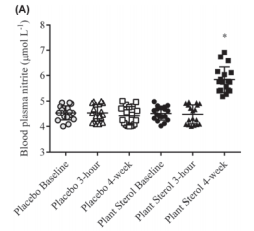
These results indicate that dietary supplementation with plant sterols, in the specified combination, can enhance the in vivo production of nitrite and nitrate, suggesting potential benefits for cardiovascular health through improved nitric oxide bioavailability.
I’ll have to add to this that the NO study was partially sponsored by the BASF NutritionTM Asia Award. I tend to ignore studies with industry sponsorship, but here, at least, the findings are plausible and congruent with some notions found elsewhere in the literature.
Anti-inflammatory Effects:
Some research suggests phytosterols may have anti-inflammatory properties. Inflammation is a risk factor for many chronic conditions, including heart disease, so phytosterols might offer protective benefits beyond cholesterol management.
Prostate Health and hair regeneration:
In “BIOS Needs Free Testosterone” we’ll see how the conversion of testosterone to another specific form of testosterone named DHT, leads to a pandemic of hair loss, benign prostate hyperplasia, and prostate cancer.
One reason why we suffer from these high DHT levels, is due to age-related increases in an enzyme named 5α-reductase (5αRs). Phytosterols have a structural similarity with other molecules and substances that are known 5αRs inhibitors. This has led to authors speculating about phytosterols being potent therapeutic agents in the prevention and treatment of high DHT levels.
And indeed, there is evidence to suggest that phytosterols may have beneficial effects on prostate health, including a potential role in reducing the symptoms of benign prostatic hyperplasia (BPH), a condition characterized by the enlargement of the prostate gland. By the time men reach the age of 70, almost 80% of them will suffer from BPH. Even more so, several studies suggest that phytosterols (13) exhibit anti-cancer properties against prostate cancer.
Drugs for hair loss and balding like finasteride and dutasteride are 5αRs inhibitors, phytosterols stand as the strongest promising candidate for plant-derived 5αRis. Phytosterols being able to exhibit dual inhibition on both isoforms of 5αRs, further strengthens its potential as the most potent plant-derived 5αRis, while not having to resort to drugs.
I’ve subsequently covered the research but did not find any spectacular results from PS for hair loss. But, while writing an article on hair loss, I did find some work on how small amounts of pumpkin seeds or pumpkin seed oils (400mg of pumpkin seed oil, sometimes even after taking just a few pumpkin seeds a day), were able to block 5α-reductase and enable hair regrowth. However, most research of it came from developing countries, which I find difficult to trust. The results were replicated in Korea though by (Young Hye Cho, 2014). If pumpkin seed PS lowers DHT and prevents hair loss from it, I speculated that it should likewise be able to ameliorate BPH through the same mechanism. And indeed, Eszter Csikós (2021), explains how BPH showed relief after 500 mg of pumpkin seed extracts in an overview of various RCTs carried out using pumpkin products in the last couple of decades.
Yet again, I wasn’t satisfied with these results, how could pumpkin seeds have this strong DHT-lowering effect, while other nuts and seeds, also rich in phytosterols, didn’t appear to work? Neither did the common phytosterol forms like beta and campe and stigmasterol. That’s when I accidentally bumped into research showing that a specific subtype of PS, Δ 7 -sterol was a potent DHT inhibitor.
Delta-7-sterols are a group of phytosterols with a specific double bond at the 7th carbon position. They generally make up a smaller portion of the total phytosterols compared to beta-sitosterol, campesterol, and stigmasterol and as a minor subtype, they turned out to be relatively uncommon in food sources, except for one or two plant families, including the Cucumber Family (Cucurbitaceae). And lo and behold, pumpkin seeds are exceptionally high in Δ 7 subtype phytosterols from within this selection and among all possible foods. Solved the mystery, unfortunately, I can’t find my references on my computer anymore. If I find them, I’ll update this article.
Cancer prevention and treatment:
Intake of dietary phytosterols (campesterol, stigmasterol, and β-sitosterol) before diagnosis is associated with improved overall survival in ovarian cancer patients (1). A phytosterol-rich diet may reduce the risk of cancer by 20% (5). For example, β-Sitosterol (SIT), has shown potential as a cancer preventive and therapeutic agent due to its multifaceted anticancer activities observed in preclinical studies. These activities span various mechanisms, including apoptosis enhancement, cell cycle arrest, oxidative stress regulation, metabolic reprogramming, invasion and metastasis inhibition, immunity and inflammation modulation, and drug resistance combat (2)(3).
Various PSs, such as ergosterol, stigmasterol, sitosterol, withaferin A, etc., have been reported for their anti-cancer activities against a variety of cancers by modulating the tumor microenvironment via molecular signaling pathways discussed within the article. These signaling pathways are associated with the production of pro-inflammatory mediators, growth factors, chemokines, and pro-apoptotic and anti-apoptotic genes. These mediators and their upstream signaling are very active within the variety of tumors and by modulating these signalings, thus PS exhibits promising anti-cancer activities.
Phytosterols and phytostanols are already clinically recommended for cardiovascular disease risk reduction, and represent promising anti-cancer agents that could be delivered in clinics and to the general population at low cost, with a well-understood safety profile, and now with a robust understanding of mechanism-of-action. (Cioccoloni, 2022).
Neuroprotection and brain health:
It has been shown that upon chronic high intake plant sterols accumulate in the brain (Vanmierlo et al., 2012; Saeed et al., 2015). Even though the mammalian blood-brain barrier (BBB) is not, or very poorly, permeable to cholesterol, studies have shown that phytosterols like sitosterol and campesterol can cross the BBB in mice.
Phytosterols, such as stigmasterol and β-sitosterol, can cross the BBB and accumulate in the brain aking to oxysterols (9). This is significant because it suggests that phytosterols have the potential to modulate various pathways in the brain linked to neurodegeneration. Reduced cholesterol has been observed in the brains of aged individuals, in people who successfully commit suicide, and in those with neurodegenerative diseases. Furthermore, restoring brain cholesterol in aged mice reverses their cognitive deficits. While serum cholesterol doesn’t cross the blood-brain barrier, the brain produces its cholesterol, it has been shown that PS can carry circulating cholesterol across the BBB, enhancing brain levels. This mechanism (Sodero, 2023) has been able to lower hearing loss in mice. More on this in “BIOS Needs Brain”.
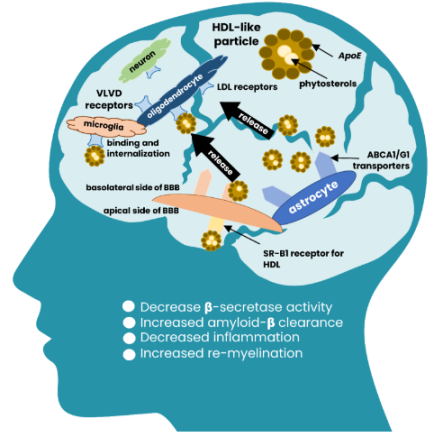
Phytosterols, including stigmasterol and β-sitosterol, play a role in neuroprotection through mechanisms such as anti-inflammatory effects, antioxidant properties, modulation of cholesterol metabolism, and inhibition of amyloid-beta peptide aggregation, which are critical in regulating neuroinflammatory pathways (4). These compounds have demonstrated their potential as metabolic modulators in neurodegenerative diseases, particularly in managing memory deficits associated with Alzheimer's disease (AD).
Furthermore, β-sitosterol exhibits a multi-target potential in addressing memory deficits in AD by reducing brain amyloid-beta (Aβ) levels and γ-secretase activities. This suggests the benefits of a diet enriched with plant sterols for individuals with neurodegenerative conditions. B-amyrin, another phytosterol, has been shown to protect dopaminergic neurons and reduce cell damage and α-synuclein aggregation, which are indicative of Parkinson's disease (PD) symptoms.
Research, including studies by Schepers et al., highlights the efficacy of marine-based phytosterols such as fucosterol, 24(S)-saringosterol, sitosterol, and stigmasterol in reducing Aβ plaque formation and ameliorating memory deficits. These studies also point to fucosterol's ability to elevate acetylcholine levels in the brain and 24(S)-saringosterol's capacity to enhance Aβ clearance, further establishing the broad spectrum of phytosterol benefits in combating neurodegenerative diseases.
However, it's important to note that while phytosterols have been shown to have health benefits, particularly in lowering cholesterol levels, their effects are not solely beneficial. High levels of BSSG, the glycosylated (attached a carbohydrate) form of β-sitosterol (β-sitosterol-β-D-glycoside), particularly from chronic high intake of certain plants, have been associated with potential neurotoxic effects and may contribute to the development of neurodegenerative diseases under certain conditions.
The exposure to high amounts of BSSGs amounts present in the seed of the cycad tree (Cycas micronesica) has been speculated to underly the historically high prevalence of the neurodegenerative disease amyotrophic lateral sclerosis–parkinsonism dementia complex (ALS–PDC) at the island of Guam (Tabata et al., 2008). And feeding it to rats tends to have the same effect. We definitely, shouldn’t be overdoing the dosing.
Phytosterols (PSs) are present in low concentrations in the bloodstream, significantly lower than cholesterol levels, and are considered safe for daily supplementation even at high doses (9 to 30 g/day). However, their levels can slightly increase following the consumption of PS-enriched foods. In mice, a diet enriched with plant sterol esters for six weeks led to a two- to threefold increase in PS concentrations in serum, liver, and brain, with accumulation in the brain being virtually irreversible. Similarly, long-term consumption of PS-enriched margarine can slightly elevate circulating levels of sitosterol and campesterol, which remain within the normal range for healthy individuals (Feng, 2019).
Interestingly, phytosterol levels are higher in the normal brain compared to those in Alzheimer's disease (AD) patients, suggesting a potential role in brain health, including anxiolytic effects and cognitive improvement. (Fan Jie, 2022).
Infants, particularly those with very low birth weight, exhibit a rapid increase in circulating PS levels and a slow elimination rate, indicating a reduced ability to metabolize PSs, partly due to ABCG5/G8 dysfunction. Interestingly, human mothers’ milk contains a fraction of 0.5% cholesterol, which is important for growing the baby. Breast milk also contains phytosterols, but in a specific ratio of higher sitosterol than campesterol, not merely as a reflection of how they circulate in the mother. This suggests that PS has a specific role in infant growth.
Microbiome:
Plant sterols may be viewed as promoters of beneficial species abundance (Cuevas-Tena et al., 2018). Some bacteria in the gut are capable of metabolizing plant sterols, which can affect their absorption and bioavailability, and this could enrich the composition of the overall microbiome.
Activates endogenous antioxidant systems:
Up-regulation of antioxidant enzymes such as HO-1 (heme oxygenase-1), SOD, and CAT, via the Nrf2/ARE signaling pathways (7).
Anti-aging and skin regeneration:
Cholesterol maintenance and amelioration of neurodegenerative conditions are not the only applications of plant sterols. Skin regeneration and wound healing are becoming one of the largest fields, where dietary sterols are widely utilized and originated from traditional Thai and Chinese medicine. The biochemical investigations indicate that skin injury regeneration is accelerated through the anti-inflammatory properties of plant sterols in the same manner as has been touched above for neurodegenerative diseases.
Immune system modulation
Potential effects of plant sterols and stanols on different cells and cell-cell interactions of the immune system. F.e. on regulatory T-cells. (Plat, 2019).
Can raise hormone levels, such as DHEA and testosterone
Dietary plant sterols can act as precursors for DHEA (dehydroepiandrosterone) in humans. DHEA is a crucial hormone with various potential benefits, including supporting immune function, energy levels, and bone health. The conversion involves specific enzymes working together: lathosterol oxidase, 3β-hydroxysteroid dehydrogenase, ∆24-sterol reductase, ∆7-sterol 5-desaturase, and cytochrome CYP51A1. Each enzyme plays a role in transforming the plant sterol structure into DHEA.
The impact of plant sterols on the level of serum testosterone has been revealed in animals who were intentionally treated with functional food enriched with β-sitosterol. Mice fed PS have higher testosterone levels in males and higher estrogen levels in females. These observations point to the direct involvement of plant sterols in modulating sex hormone levels, possibly by serving as steroid precursors rather than through receptor-mediated mechanisms. Such outcomes indicate a biochemical pathway where plant sterols could be integrated into the steroidogenic processes, influencing the hormonal milieu without necessarily altering the activity of enzymes responsible for steroid synthesis or cholesterol transformation.
The involvement of steroids in plant growth and reproductive processes, as evidenced by the impact of estrogens on flowering and the identification of estrogen-binding proteins in plants, reveals a parallel between plant and mammalian hormonal regulation. These findings suggest a shared evolutionary mechanism for hormone action across diverse life forms, emphasizing the potential for plant-based compounds to interact with mammalian systems in ways that are still being unraveled. Overall, the interconnection between plant sterols, steroid hormones, and biological systems presents a picture of mutual influence and potential therapeutic applications. The ability of plant sterols to act as precursors for human steroids opens avenues for research into dietary interventions and the development of functional foods aimed at modulating hormone levels and improving health outcomes.
Anabolic
The direct effects of phytosterols on protein synthesis rates, particularly in the context of human physiology, are not as extensively documented in the scientific literature as the effects of other plant-derived compounds, such as ecdysteroids or brassinosteroids, which have been studied for their potential to enhance protein synthesis and exhibit anabolic effects.
Phytosterols (PS) have been investigated for their potential to influence various cellular signaling pathways, including Akt signaling (11). Akt, also known as Protein Kinase B (PKB), is a critical kinase in cellular processes such as glucose metabolism, apoptosis, cell proliferation, transcription, and cell migration. Activation of the Akt signaling pathway can promote protein synthesis and inhibit protein degradation, which are key processes in muscle growth and maintenance.
Yet, the observed and repeatedly demonstrated ability of plant sterols to enhance the rate of protein synthesis and to diminish the rate of protein degradation aspires to persuade (T. Kopylov, et al., 2021) of the potential anabolic effect of dietary plant sterols. Furthermore, it is well known that activation of Akt signaling may sufficiently support the increase of muscle mass (up to 50% within three weeks on the targeted stimulation) with no obligation to activate satellite cells.
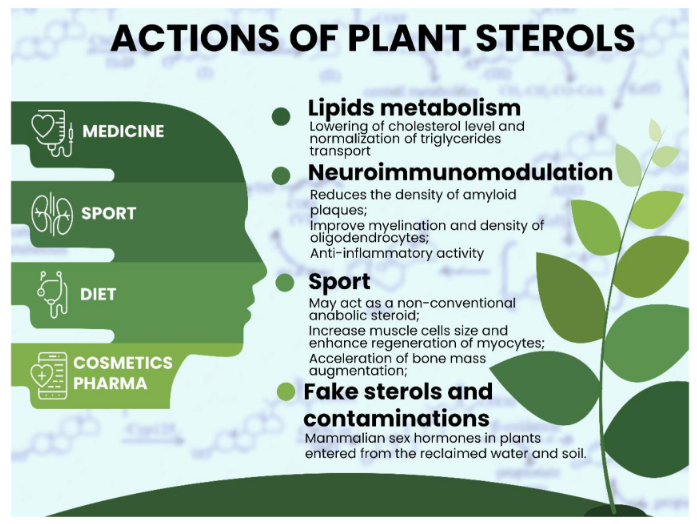
CONCLUSION
-
Supplement daily with phytosterols in a dose ranging from 300mg to 1000mg. Don’t consume margarine (a highly processed food) that boasts PS enrichment. Rather, use an isolated pharmaceutical form directly and consume the tablet during a meal that has fat or emulsifiers, either solid or liquid.
Phytosterols (PSs) and phytosterol esters (SEs) have been recognized for their health benefits, particularly in reducing the risk of coronary heart disease. Both the U.S. Food and Drug Administration (FDA) and the European Commission (EC) have acknowledged these benefits, granting PSs and SEs "Generally Recognized as Safe" (GRAS) status and approving health claims for their use in various food products.
Stick to 300mg as a prudent dose, as at least some of the literature warns against PS accumulation in tissues leading to disease potential, whereas on the other hand, most of the literature assumes this accumulation would be beneficial. In the latter case, take anywhere near 800mg to 1000mg daily.
I am hesitant to advise anything above 1 gram daily, as this could potentially be stretching normal evolutionary intake levels. I’ll leave it up to you to decide whether you’re going to subtract your daily dietary PS intake (300-400mg) from these dosages.
-
Take a phytosterol supplement (especially campesterol, although a general PS tab is suitable too) as a pre-workout, 2 hours before match time/exercise, to increase nitric oxide levels after having supplemented this dose daily for at least 3 weeks prior.
-
Eat seaweeds, these have unique PS. For example, fucosterol is a type of phytosterol found in various species of seaweed and is recognized for its potential health benefits, including anti-inflammatory, antioxidant, anticancer, and cholesterol-lowering effects. Wakame (Undaria pinnatifida), a type of edible seaweed commonly used in Asian cuisine, particularly in miso soups, salads, and side dishes, is one of the seaweeds known to contain fucosterol among other beneficial compounds. Wakame is my weapon of choice to safely increase seaweed intake on BIOS-DIET. Mainly because it is lower in iodine, which lowers risk. Seaweeds were recommended in BIOS Needs Fiber too for unique fiber types. And will again be recommended in other BIOS articles because of its valuable sulfated polysaccharides which can strengthen the endothelial cells and extracellular matrix.
-
Take … against aged-related increases in DHT hormone to prevent balding and prevent prostate enlargement and prostate cancer. (TBD)
-
Enzymatically mixing the phytosterols with DHA into PS-DHA would increase the absorbability of the omega-3, and brain uptake too, leading to a better therapeutic effect for brain and hearing health. (12)(10). I did not find any commercialized PS-DHA brand, so this remains a research chemical. But you could try taking your PS at the same time as your omega-3-rich meal, or supplement to emulate the effect. And indeed, combining dietary intake of omega-3 long-chain fatty acids and plant sterols may offer synergistic effects on the plasma lipid profile, potentially offering an improved strategy for preventing cardiovascular risk (Badimon, 2016).
-
Supplement with a pumpkin seed extract, preferably a type specifically grown to be high in Δ 7 phytosterols. Use as per the dosing instructions. DM me for a specific brand if you have trouble finding one. Alternatively, you could use a cold-pressed, organic, unprocessed pumpkin oil bottle and take a teaspoon once or twice a day. It has a pungent taste, if that’s missing, you probably bought a low-quality oil. The sooner you can start the lower your chance of developing high levels of DHT, and the lower your risk for age-related hair loss, BPH, and prostate cancer, which are pandemic in our society. Women stand to benefit from lower DHT too.
--(1) Zhao, J. Q., Hao, Y. Y., Gong, T. T., Wei, Y. F., Zheng, G., Du, Z. D., ... & Zhao, Y. H. (2022). Phytosterol intake and overall survival in newly diagnosed ovarian cancer patients: An ambispective cohort study. Frontiers in Nutrition, 9, 974367.
(2) Wang, H., Wang, Z., Zhang, Z., Liu, J., & Hong, L. (2023). Beta-sitosterol as a promising anticancer agent for chemoprevention and chemotherapy: mechanisms of action and future prospects. Advances in Nutrition.
(3) Chen, Y., Yin, S., Liu, R., Yang, Y., Wu, Q., Lin, W., & Li, W. (2023). β-Sitosterol activates autophagy to inhibit the development of hepatocellular carcinoma by regulating the complement C5a receptor 1/alpha fetoprotein axis. European Journal of Pharmacology, 957, 175983.
(4) Refaey, M. S., Shah, M. A., Fayed, M. A., Rasul, A., Siddiqui, M. F., Qasim, M., ... & Eldahshan, O. A. (2023). Neuroprotective effects of steroids. In Phytonutrients and Neurological Disorders (pp. 283-304). Academic Press.
(5) Nattagh‐Eshtivani, E., Barghchi, H., Pahlavani, N., Barati, M., Amiri, Y., Fadel, A., ... & Ghavami, A. (2022). Biological and pharmacological effects and nutritional impact of phytosterols: A comprehensive review. Phytotherapy Research, 36(1), 299-322.
(6) Khan, A. U., Khan, A., Shal, B., Khan, S., Khan, M., Ahmad, R., & Riaz, M. (2023). The critical role of the phytosterols in modulating tumor microenvironment via multiple signaling: A comprehensive molecular approach. Phytotherapy Research.
(7) Sohn, S. I., Rathinapriya, P., Balaji, S., Jaya Balan, D., Swetha, T. K., Durgadevi, R., ... & Pandian, S. (2021). Phytosterols in seaweeds: An overview on biosynthesis to biomedical applications. International Journal of Molecular Sciences, 22(23), 12691.
(8) Abumweis, S., Barake, R., & Jones, P. (2008). Plant sterols/stanols as cholesterol lowering agents: a meta-analysis of randomized controlled trials. Food & nutrition research, 52(1), 1811.
(9) Sharma, N., Tan, M. A., & An, S. S. A. (2021). Phytosterols: Potential metabolic modulators in neurodegenerative diseases. International Journal of Molecular Sciences, 22(22), 12255.
(10) Tan, Z., Le, K., Moghadasian, M., & Shahidi, F. (2012). Enzymatic synthesis of phytosteryl docosahexaneates and evaluation of their anti-atherogenic effects in apo-E deficient mice. Food chemistry, 134(4), 2097-2104.
(11) Xiong, M., Huang, Y., Liu, Y., Huang, M., Song, G., Ming, Q., Ma, X., Yang, J., Deng, S., Wen, Y., Shen, J., Liu, Q., Zhao, P., & Yang, X. (2018). Antidiabetic Activity of Ergosterol from Pleurotus Ostreatus in KK‐Ay Mice with Spontaneous Type 2 Diabetes Mellitus. Molecular Nutrition & Food Research, 62, &NA;. https://doi.org/10.1002/mnfr.201700444.
(12) Song, L., Zhao, X. G., Ouyang, P. L., Guan, Q., Yang, L., Peng, F., ... & Yan, H. (2020). Combined effect of n-3 fatty acids and phytosterol esters on alleviating hepatic steatosis in non-alcoholic fatty liver disease subjects: A double-blind placebo-controlled clinical trial. British Journal of Nutrition, 123(10), 1148-1158.
(13) Azizi, A., Mumin, N. H., & Shafqat, N. (2021). Phytochemicals With Anti 5-alpha-reductase Activity: A Prospective For Prostate Cancer Treatment. F1000Research, 10.
(14) Jenkins, D. J., Kendall, C. W., Marchie, A., Jenkins, A. L., Connelly, P. W., Jones, P. J., & Vuksan, V. (2003). The Garden of Eden—plant based diets, the genetic drive to conserve cholesterol and its implications for heart disease in the 21st century. Comparative Biochemistry and Physiology Part A: Molecular & Integrative Physiology, 136(1), 141-151.
(15) Ho, X. L., & Loke, W. M. (2017). Dietary plant sterols supplementation increases in vivo nitrite and nitrate production in healthy adults: a randomized, controlled study. Journal of food science, 82(7), 1750-1756.




评论 (0)